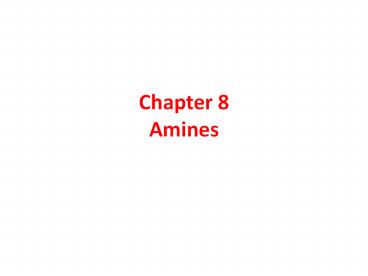Chapter 8 Amines PowerPoint PPT Presentation
1 / 24
Title: Chapter 8 Amines
1
Chapter 8Amines
2
Introduction
- Organic derivatives of ammonia.
- Many are biologically active.
3
Additional Amines
4
Biological Activity
- Neurotransmitters dopamine
- Bioregulators epinephrine
- Vitamins niacin, B6
- Alkaloids nicotine, morphine, cocaine
- Amino acids
5
Classes of Amines
- Primary (1?) one C-N bond, 2 N-H bonds.
- Secondary (2?) two C-N bonds, 1 N-H bond.
- Tertiary (3?) three C-N bonds, no N-H bond.
- Quaternary (4?) four C-N bonds, nitrogen has a
formal charge.
6
Classify
7
Common Names
- Name the alkyl or aryl groups bonded to nitrogen,
then add suffix -amine.
diethylmethylamine
cyclohexyldimethylamine
diphenylamine
8
Amine as Substituent
- On a molecule with a higher priority functional
group, the amine is named as a substituent.
?-aminobutyric acid (common) or 4-aminobutanoic
acid (IUPAC)
2-methylaminophenol (IUPAC)
9
Aromatic Amines
- Amino group is bonded to a benzene ring. Parent
compound is called aniline.
10
IUPAC Names
- Name is based on longest carbon chain.
- -e of alkane is replaced with -amine.
- Substituents on nitrogen have N- prefix.
3-bromo-1-pentanamine
N,N-dimethyl-3-hexanamine
11
Structure of Amines
- Nitrogen is sp3 hybridized with a lone pair of
electrons in an sp3 orbital.
12
Chirality of Amines
- Nitrogen may have 3 different groups and a lone
pair, but enantiomers cannot be isolated due to
inversion around N.
13
Boiling Points
- N-H less polar than O-H.
- Weaker hydrogen bonding.
- Tertiary amines cannot hydrogen bond.
14
Solubility and Odor
- Small amines (lt6 C) soluble in water.
- All amines accept hydrogen bonds from water and
alcohol. - Branching increases solubility.
- Most amines smell like rotting fish.
15
Basicity of Amines
- Lone pair of electrons on nitrogen can accept a
proton from an acid - Aqueous solutions are basic to litmus.
- Ammonia pKb 4.74
- Alkyl amines are usually stronger bases than
ammonia. Increasing the number of alkyl groups
decreases solvation of ion, so 2? and 3? amines
are similar to 1? amines in basicity.
16
Energy Diagram
- Alkyl groups are electron-donating and stabilize
the cation.
17
Resonance Effects
- Any delocalization of the electron pair weakens
the base.
18
Hybridization Effects
- Electrons are held more tightly in orbitals with
more s character, so those compounds are weaker
bases.
19
Amine Salts
- Ionic solids with high melting points
- Soluble in water
- No fishy odor
20
Alkylation of Amines
- Amines react with 1? alkyl halides via the SN2
mechanism. - Mixtures of the mono-, di-, and tri-alkylated
products are obtained.
21
Direct Alkylation (1?)
- Use a large excess (101) of ammonia with a
primary alkyl halide. - Reaction mechanism is SN2.
22
Nitrile Reduction (1?)
- Nitrile, -C?N, is a good SN2 nucleophile.
- Reduction with H2 or LiAlH4 adds -CH2NH2.
23
Reduction of Nitro Compounds (1?)
- -NO2 is reduced to -NH2 by catalytic
hydrogenation, or active metal with acid. - Commonly used to synthesize anilines.
24
End of Chapter 8

